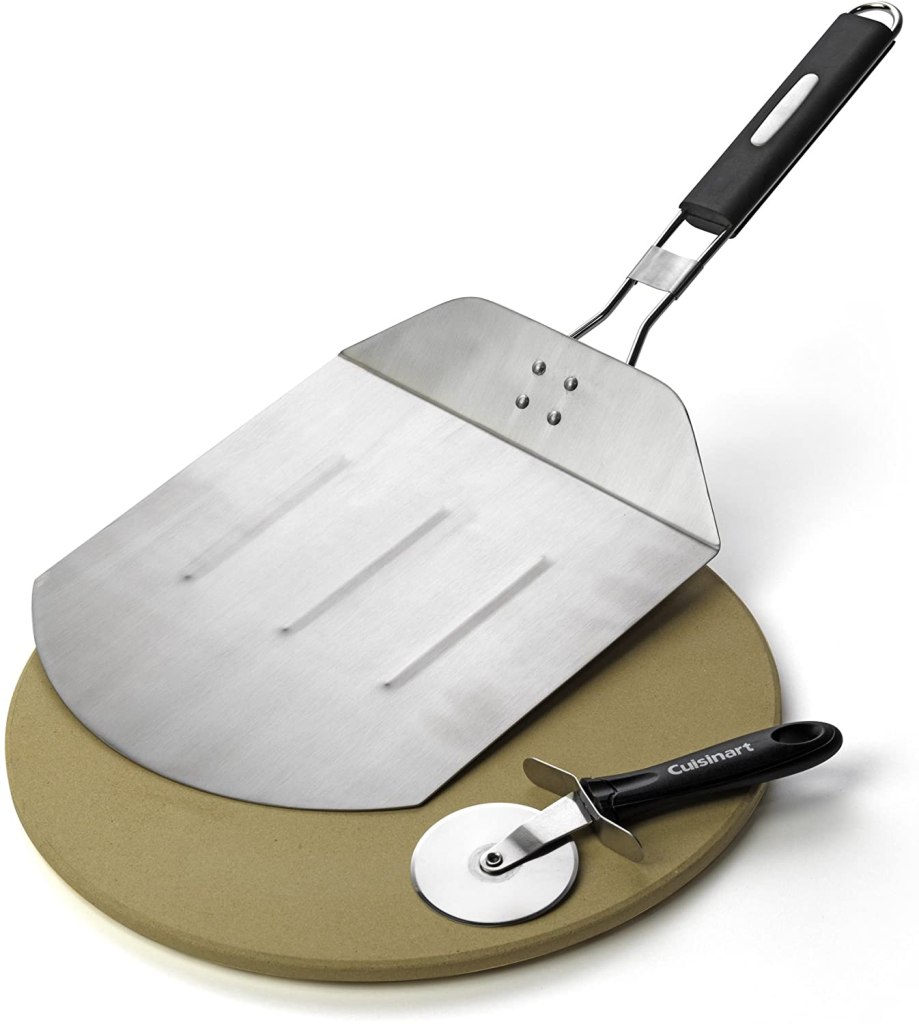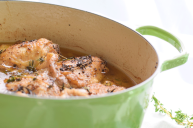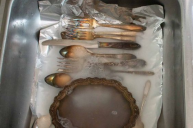Whether you received your pizza stone as a gift or bought one for yourself to make delicious homemade pizzas with crispy crusts at home, you need to know how to take care of this must-have pizza lover's cookware. A pizza stone can be fragile and likely to crack so knowing how to clean a pizza stone and how to maintain a clean pizza stone correctly is what we're going to cover.
Videos by Wide Open Country
A pizza stone is made of porous material so whatever comes in contact with it can affect your pizza in the end. They can be made of ceramic, cast iron, or (obviously) stone. You never want to use dish soap to clean a pizza stone. It can leave a soapy taste with your next pizza. Also never submerge it in water.
3-Piece Pizza Grilling Set
Water is like Kryptonite when it comes to pizza stones and you want to use it as little water as possible. Any moisture that touches the stone remains trapped for a while. And since pizza dough has moisture, you don't want to add any more or you won't get that crispy crust of your pizza dreams. No soapy water overnight soaks for your pizza stone. Ditch that big bottle of Palmolive but keep that scouring pad.
Other tools you can use for scraping off stuck-on food are a bench scraper, a butter knife, plastic spatula or a metal spatula, a stone brush, or even an old toothbrush come in handy. Tools that are slightly abrasive will do the job for cleaning any burnt food or crusty bits. You can use a lightly damp cloth if you must but never soap and water or chemicals.
There's no need to clean off any olive oil that you use in your pizza recipe. That olive oil gets absorbed into the pizza stone and creates a natural non-stick surface. Slide your scraper under the food bits and wipe away any loosened crumbs. Use a damp cloth only if absolutely necessary. Air dry your fragile pizza stone. Remember: For your pizza stone to work its best, it needs to be 120% dry!
Out Damned Spot! How Do I Clean Pizza Stone Stains?
https://www.instagram.com/p/BkAcXWtnvzS/
Even though Shakespeare and Lady Macbeth most likely didn't own pizza stones, a discoloration on your pizza stone can drive you crazy if you're a clean freak. Unfortunately, you need to change your mindset. Those stains are just signs of use and delicious pizzas of meals past, but if they're driving you as crazy as Lady Macbeth, try this cleaning method.
Pizza Stone Fact: a stained pizza stone works just as well as a spotless one. It may even work better since the stone has absorbed oils and been seasoned through high temperatures in the oven.
First, scrape away any pieces of food or burnt pizza crust with your spatula or stone brush. Mix up equal parts warm water and baking soda and scrub the paste on any stains in circular motions. Leave it on for a few minutes and then wipe it off with a damp cloth. Remember: Don't rinse the entire stone under the faucet! Let it air dry.
How To Clean a Burned Pizza Stone
You got caught up in Netflix. You fell asleep. You zoned out staring at a squirrel family. Whatever your reason, you now have burned on food that won't budge. Try this method.
Place your pizza stone in the oven on the top rack and set oven to bake at 500 degrees F for an hour. The food should all start burning off and away from the stone. Let the stone cool before removing! Wipe it all off with a soft cloth. For really bad burns, you can use medium grit sandpaper with light elbow grease.
How To Clean Mold From a Pizza Stone
Trapped moisture can cause mold to grow. One of the most common ways this happens is when you only use your pizza stone occasionally. You wrapped it up and put it back in the original box when it wasn't completely dry. It's an honest mistake.
The best way to avoid this is to simply "store" your pizza stone in the oven 24/7 and 365! The gradual heating and cooling with regular oven use is actually good for it! Plus it doesn't get handled as much, which is a safer way to avoid any breaking or cracking.
Back to the offending moldy spots. Measure out about a teaspoon of baking soda and splash with vinegar. Scrub the mold with a toothbrush and the mixture. If it's really bad, you may have to toss the stone. Remember: Never use bleach or any harsh chemicals on the mold or the pizza stone in general.
Avoid Drastic Temperature Changes
Back in high school, the pizzeria on the boardwalk at the Jersey Shore brought over the cutest boys from England to work. My girlfriends and I would ogle them using those big pizza paddles or pizza peels as they're really called. We giggled as we ordered our slices and Diet Cokes just to hear those dreamy accents say "thank you" and "enjoy your pizza."
Those days are gone but the pizza peel is still a good thing to own when making homemade pizza. If you have a metal pizza peel (the easier style to use) sprinkle some cornmeal or flour on it to keep it your dough from sticking to it when transferring your pizza to to the preheated pizza stone.
If you're cooking a frozen pizza on your stone, let it come to room temperature first. That way your hot pizza stone won't get a cold shock when you place it on top and possibly crack. Never place a cold stone in a hot oven
The pizza stone always stays in the oven and should be allowed to cool down gradually. Use your peel to put in and take out your pizza, just like those English boys did in 1986.
Products featured on Wide Open Eats are independently selected by our editors. However, when you buy something through our links, we may earn a commission.






